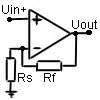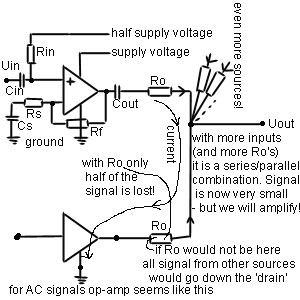The simple song:
It is organised as building blocks,
combined according to personal taste and need,
best if organised on a pre-drilled universal printed circuit board,
with holes for the input, output sockets, potentiometers,
all drilled into pcb,
then screwed and fixed with bolts,
with holes-conforming alu frontplate drilled in parallel,
and later pushed over it,
which would even act as Faraday cage,
besides being nice & shinny;
solution for the bottom?
-> I leave totally to your aesthetic touch,
but the mixer will be 'elegantly' slim,
because we'll use an outside universal power plug.
This is what Monika wanted
And here is a 'physical' layout
consisting of:
-> one microphone preamp,
-> one (passive) stereo line input,
-> one channel output amplifier,
-> stabilizer circuit
... and its elements follow (with certain variations):
but before the nice drawings download there is time for a brief 'basics'
course!
and now the nice drawings must have downloaded!

 all input signal grounds
should go directly to stabilizer one-point ground, (however - they can
be first connected connected all together)
all input signal grounds
should go directly to stabilizer one-point ground, (however - they can
be first connected connected all together)
 the alu frontplate should
be connected only once to ground -> at a microphone input (the most sensitive
one),
the alu frontplate should
be connected only once to ground -> at a microphone input (the most sensitive
one),
capacitor at the input should be 1microfarad plastic foil, resistor
100Kohm going from the input socket to ground is to prevent a 'thump' when
connecting an input cable;
 there is a possibility for
a 'phantom' microphone supply - the red resistor; attention: there are
electret microphones which have an additional ring -> like the stereo
mini jacks - these get their 'phantom' power at the ring (get a stereo
input socket!) - connect the red resistor on the ring;
there is a possibility for
a 'phantom' microphone supply - the red resistor; attention: there are
electret microphones which have an additional ring -> like the stereo
mini jacks - these get their 'phantom' power at the ring (get a stereo
input socket!) - connect the red resistor on the ring;
 the trimmer may serve for
setting the input sensitivity but it can be also eliminated - together
with the associated 10 microfarad electrolitic capacitor.
the trimmer may serve for
setting the input sensitivity but it can be also eliminated - together
with the associated 10 microfarad electrolitic capacitor.

 Micro preamp is the simplest
operational amplifier non-inverting design, therefore a good op-amp is
needed (TL 071, NE 5534, CA 3140); the design is for single voltage supply
(and op-amps are not), therefore half_the_supply voltage line is needed
everywhere.
Micro preamp is the simplest
operational amplifier non-inverting design, therefore a good op-amp is
needed (TL 071, NE 5534, CA 3140); the design is for single voltage supply
(and op-amps are not), therefore half_the_supply voltage line is needed
everywhere.
 also: very close to every
op-amp a couple of 'blocking' capacitors (0,1microfarad 50V ceramic) are
needed (to block the noise from the two voltage supply lines).
also: very close to every
op-amp a couple of 'blocking' capacitors (0,1microfarad 50V ceramic) are
needed (to block the noise from the two voltage supply lines).
 For stereo (or mono) line
inputs no op-amp is used, just resistor from the input socket to the ground
and capacitor from the input socket to the next (mixing, prelistening,
send) stage;
For stereo (or mono) line
inputs no op-amp is used, just resistor from the input socket to the ground
and capacitor from the input socket to the next (mixing, prelistening,
send) stage;
 however, adding a 'buffer'
stage (-> a mic preamp with feedback resistor replaced by a wire) can make
things easier with send potentiometers (-> cheaper and smaller!). Double
op-amps can be used (also 8 pins/ same price! -> NE 5532, TL 072,...).
however, adding a 'buffer'
stage (-> a mic preamp with feedback resistor replaced by a wire) can make
things easier with send potentiometers (-> cheaper and smaller!). Double
op-amps can be used (also 8 pins/ same price! -> NE 5532, TL 072,...).

 this is how a buffer (with
double op-amp) looks like:
this is how a buffer (with
double op-amp) looks like:
 The place for pre-fader (pfl)
send potentiometers is just before main mixer faders (one more SUM amp
is needed -> for mono send submix).
The place for pre-fader (pfl)
send potentiometers is just before main mixer faders (one more SUM amp
is needed -> for mono send submix).
 The elements for send submix
are in yellow colour. If you don't need send submix you can eliminate all
the yellow elements. If you need more submix groups just replicate same
' yellow' configurations.
The elements for send submix
are in yellow colour. If you don't need send submix you can eliminate all
the yellow elements. If you need more submix groups just replicate same
' yellow' configurations.
 Double potentiometers are
necessary because we don't use 'buffers' for the line inputs (-> look up
Double potentiometers are
necessary because we don't use 'buffers' for the line inputs (-> look up  ).
).
 Faders here are rotary logaritmic
potentiometers (instead of 'sliders' which are not cheap, or no good!),
however better (more expensive) pots will serve you better, double for
the stereo input control, single for the mono/ microphone control.
Faders here are rotary logaritmic
potentiometers (instead of 'sliders' which are not cheap, or no good!),
however better (more expensive) pots will serve you better, double for
the stereo input control, single for the mono/ microphone control.
 After faders (through equal
value resistors) we connect (for the stereo inputs) all left to the left
sum common strip (bus), all right to the right sum common strip and for
the mono/ microphone to both (one resistor goes to left sum strip, one
resistor goes to right sum strip).
After faders (through equal
value resistors) we connect (for the stereo inputs) all left to the left
sum common strip (bus), all right to the right sum common strip and for
the mono/ microphone to both (one resistor goes to left sum strip, one
resistor goes to right sum strip).
 Prelistening can be done
easiest by pushbuttons, taking the signal from before the fader - simplest
solution uses just two-pole pushbutton (-> connected when pushed), more
practical solution needs a three-pole pushbutton (see the picture? soon!)
- one pole (the middle one in three-pole) goes to (common) prelisten line
(strip, bus) and further to the phones volume potentiometer.
Prelistening can be done
easiest by pushbuttons, taking the signal from before the fader - simplest
solution uses just two-pole pushbutton (-> connected when pushed), more
practical solution needs a three-pole pushbutton (see the picture? soon!)
- one pole (the middle one in three-pole) goes to (common) prelisten line
(strip, bus) and further to the phones volume potentiometer.
 For the stereo/ mono switch
of mixer output use a two-pole switch between the left sum strip and the
right sum strip.
For the stereo/ mono switch
of mixer output use a two-pole switch between the left sum strip and the
right sum strip.
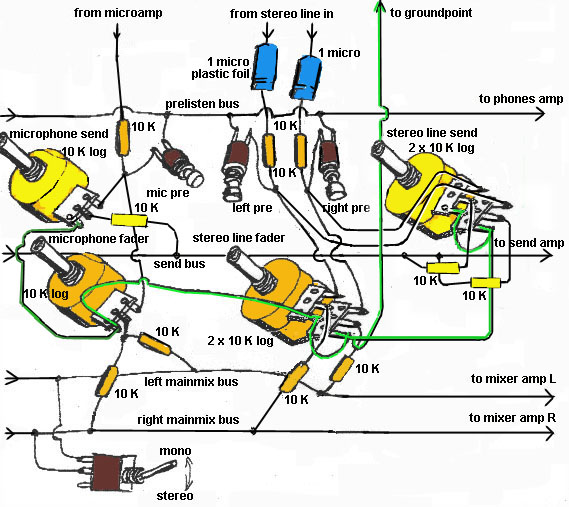

 At this point we can add
another double potentiometer (same as the above ones) for the master level
-> and now we come to summing amplifiers:
At this point we can add
another double potentiometer (same as the above ones) for the master level
-> and now we come to summing amplifiers:
 Summing amplifiers amplify
the sums of input signals and provide for the impedance transformation
(from high to low) - which serves best for feeding the output signal to
amplifier, headphones, computer,...
Summing amplifiers amplify
the sums of input signals and provide for the impedance transformation
(from high to low) - which serves best for feeding the output signal to
amplifier, headphones, computer,...
 We need two/ three kinds ->
for the prelisten/ phones, for the main mixer output, for the send submix
output (if needed).
We need two/ three kinds ->
for the prelisten/ phones, for the main mixer output, for the send submix
output (if needed).
 Again they are build in the
exactly the same manner as the microphone preamps - except the feedback
resistor (going from pin 6 to 2) is about 10 times smaller -> 10Kohms.
But for phones amplifier it should be larger -> 100Kohms. Experiment with
this (feedback) resistor!
Again they are build in the
exactly the same manner as the microphone preamps - except the feedback
resistor (going from pin 6 to 2) is about 10 times smaller -> 10Kohms.
But for phones amplifier it should be larger -> 100Kohms. Experiment with
this (feedback) resistor!
 All connections to grounds
should go separately to common ground point in stabilizer (see above) and
all the voltage supply lines should also go separately to stabilizer (and
again: blocking capacitors should be used with each op-amp).
All connections to grounds
should go separately to common ground point in stabilizer (see above) and
all the voltage supply lines should also go separately to stabilizer (and
again: blocking capacitors should be used with each op-amp).
 The best would be to think
of the ground connections which go to op-amps pins 4 as voltage supply
lines - complementary to the plus voltage supply line - these two leads
should be 'twisted' together to prevent any 'hum' induction.
The best would be to think
of the ground connections which go to op-amps pins 4 as voltage supply
lines - complementary to the plus voltage supply line - these two leads
should be 'twisted' together to prevent any 'hum' induction.
 Grounds which go from the
potentiometers are (same as input and output grounds) - 'signal' grounds.
Acting in this manner you prevent any possibility of 'buzz' or 'hum'.
Grounds which go from the
potentiometers are (same as input and output grounds) - 'signal' grounds.
Acting in this manner you prevent any possibility of 'buzz' or 'hum'.
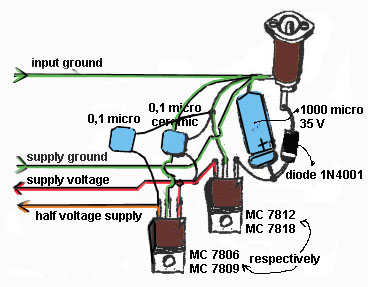
 Capacitors of 10 microfarads
are electrolitic (polarized! take care!) and they should be rated for voltages
above the supply voltage -> 25V will do. Largest electrolitic capacitor
is the 1000 microfarad in the voltage supply stabilizer part which should
have 35 V. Just for the case!
Capacitors of 10 microfarads
are electrolitic (polarized! take care!) and they should be rated for voltages
above the supply voltage -> 25V will do. Largest electrolitic capacitor
is the 1000 microfarad in the voltage supply stabilizer part which should
have 35 V. Just for the case!
 And the minus pole of this
capacitor should act as the common ground point for all the blocks!
And the minus pole of this
capacitor should act as the common ground point for all the blocks!
 We get power from an outside
'adapter' of 12V to 24V DC secondary voltage (100mA is OK), which lets
us play safely because we don't deal with lethal tensions anymore! Just
get the right socket, connect its + socket via a forward biased diode and
it will be impossible to ruin the mixer with different adapters.
We get power from an outside
'adapter' of 12V to 24V DC secondary voltage (100mA is OK), which lets
us play safely because we don't deal with lethal tensions anymore! Just
get the right socket, connect its + socket via a forward biased diode and
it will be impossible to ruin the mixer with different adapters.
 The stabilizer circuit is
the most common MC 78xx (xx = 12 or 18, which is the stabilized output
voltage). To make use of the larger dynamic range (before clipping) of
output signal - find an adapter of 18-24V DC and use MC 7818 (and MC 7809
as you'll find in the next paragraph).
The stabilizer circuit is
the most common MC 78xx (xx = 12 or 18, which is the stabilized output
voltage). To make use of the larger dynamic range (before clipping) of
output signal - find an adapter of 18-24V DC and use MC 7818 (and MC 7809
as you'll find in the next paragraph).
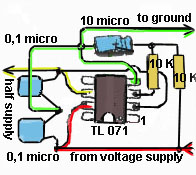
 The op-amps need a split
voltage supply, so we let them float exactly in the middle of stabilized
supply voltage and ground. This is done by voltage divider resistors and
a voltage follower (again an op-amp!) or we could use another MC 78yy (yy
= half the xx) just after the first one. The second one is a better solution
in some ways but it does not adapt if for any reason a change in main stabilised
supply voltage occurs.
The op-amps need a split
voltage supply, so we let them float exactly in the middle of stabilized
supply voltage and ground. This is done by voltage divider resistors and
a voltage follower (again an op-amp!) or we could use another MC 78yy (yy
= half the xx) just after the first one. The second one is a better solution
in some ways but it does not adapt if for any reason a change in main stabilised
supply voltage occurs.
 And that's all (for now).
In future you may expact some image files for PCBs, because the building
on the perforated board seems too much time & energy consuming.
And that's all (for now).
In future you may expact some image files for PCBs, because the building
on the perforated board seems too much time & energy consuming.
Borut


